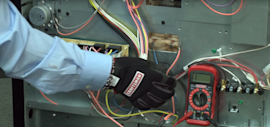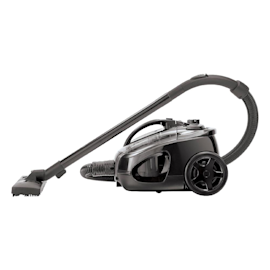Deciding between a canister or upright vacuum


How do you know which type of vacuum cleaner you should buy for your home? Understanding the differences between upright vacuum cleaners and canister vacuum cleaners—and their pros and cons—can help make the decision easier.
Canister or upright: the difference in vacuum styles
An upright vacuum cleaner contains the motor and the suction head together in one unit. An upright vacuum uses a powered brush roll that combs through carpeting to loosen embedded dirt, making it ideal for carpeted areas.
A canister vacuum has multiple pieces: a compact wheeled canister that houses the motor, a hose with a rigid nozzle and a suction head. A canister vacuum is ideal for hard floors, which don’t need a powered brush.
The pros of upright vacuums and canister vacuums
These qualities make some people devoted to their upright vacuums.
Because the unit is one piece, it’s easy to use with one hand.
You seldom have to bend over when using it.
The dust bag holds more than a canister’s dust bag.
You have several options on an upright, including self-propelled models, bagless models and models that include a hose and attachments.
These advantages are some key selling points for a canister vacuum.
A canister vacuum is easy to maneuver under furniture and in tight spaces.
Because it’s lightweight, a canister vacuum is easier to use on stairs.
The small size of a canister vacuum makes it easy to store.
Versatile attachments, including powered suction heads with brush rolls, make cleaning most surfaces in your home quick and easy.
The cons of upright vacuums and canister vacuums
In general, an upright is heavier, making it difficult to carry and use on stairs. The larger size of the suction head makes it difficult to vacuum under furniture and around tight corners. An upright vacuum cleaner can’t clean other surfaces in your home unless you choose a model with attachments.
While the versatility of a canister vacuum is great, it can be inconvenient to keep changing the nozzle attachment for different surfaces. It can also feel awkward to pull the canister behind you while using the hose in front.
Most common symptoms to help you fix your vacuum cleaners
Choose a symptom to see related vacuum cleaner repairs.
Main causes: damaged vacuum hose, clogged motor air filter, bad suction motor…
Main causes: weak suction motor, vacuum bag is full, clog in suction air path, dirty exhaust filter, leaky vacuum hose…
Main causes: broken drive belt, damaged brush roll, tripped brush roll motor overload, bad brush roll motor, wiring fail…
Main causes: lack of power, bad power cord, drive motor failure, wiring failure…
Most common repair guides to help fix your vacuum cleaners
Effective articles & videos to help repair your vacuum cleaners
Use the advice and tips in these articles and videos to get the most out of your vacuum.

Get answers to frequently asked questions about Sears and Sears PartsDirect.…

Learn how to use a multimeter to check for wiring problems in an appliance that's not working…

Find the answers to frequently asked questions about vacuum cleaners.…